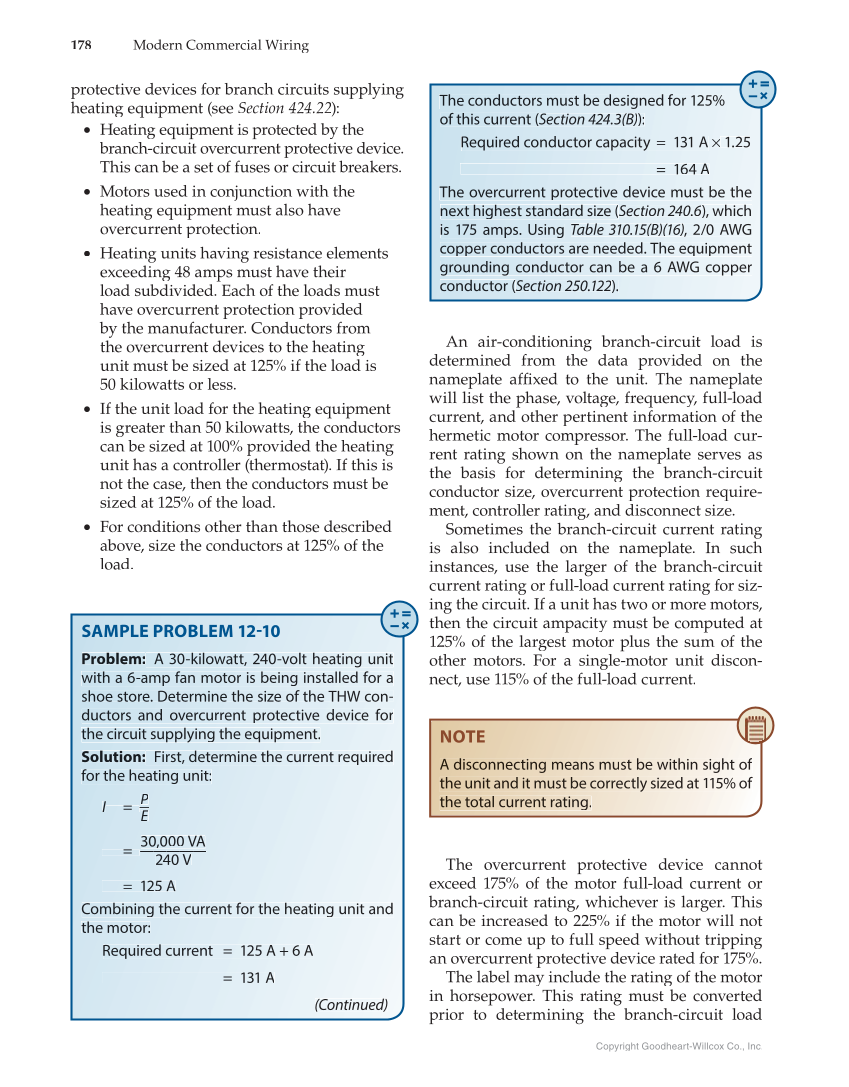178 Modern Commercial Wiring Copyright Goodheart-Willcox Co., Inc. protective devices for branch circuits supplying heating equipment (see Section 424.22): • Heating equipment is protected by the branch-circuit overcurrent protective device. This can be a set of fuses or circuit breakers. • Motors used in conjunction with the heating equipment must also have overcurrent protection. • Heating units having resistance elements exceeding 48 amps must have their load subdivided. Each of the loads must have overcurrent protection provided by the manufacturer. Conductors from the overcurrent devices to the heating unit must be sized at 125% if the load is 50 kilowatts or less. • If the unit load for the heating equipment is greater than 50 kilowatts, the conductors can be sized at 100% provided the heating unit has a controller (thermostat). If this is not the case, then the conductors must be sized at 125% of the load. • For conditions other than those described above, size the conductors at 125% of the load. SAMPLE PROBLEM 12-10 Problem: A 30-kilowatt, t 240-volt heating unit with a 6-amp fan moto or is being installed for a shoe store. Determine e the size of the THW con- ductors and overcurrent rr protective device for the circuit supplying g the equipment. Solution: First, det e te rmine the current required ed for the heating unit: n I = I P _ E = 00 __30,0___VA0 _ 240 4 V V = 125 25 A Combining n g the current for the heating g unit and the motor: o Required u current = 125 A + 6 A A = 131 A (Continued) An air-conditioning branch-circuit load is determined from the data provided on the nameplate affi to the unit. The nameplate fixed will list the phase, voltage, frequency, full-load current, and other pertinent information of the hermetic motor compressor. The full-load cur- rent rating shown on the nameplate serves as the basis for determining the branch-circuit conductor size, overcurrent protection require- ment, controller rating, and disconnect size. Sometimes the branch-circuit current rating is also included on the nameplate. In such instances, use the larger of the branch-circuit current rating or full-load current rating for siz- ing the circuit. If a unit has two or more motors, then the circuit ampacity must be computed at 125% of the largest motor plus the sum of the other motors. For a single-motor unit discon- nect, use 115% of the full-load current. The overcurrent protective device cannot exceed 175% of the motor full-load current or branch-circuit rating, whichever is larger. This can be increased to 225% if the motor will not start or come up to full speed without tripping an overcurrent protective device rated for 175%. The label may include the rating of the motor in horsepower. This rating must be converted prior to determining the branch-circuit load The conductors mu us t be designed for 125% of this current (Sec ct ion 424.3(B)): Required cond du ctor capacity = 131 A × × 1.25 = 164 A The overcurrent t protective device must be b the next highest standard a size (Section 240.6), ), which is 175 amps. Us U si ng Table 310.15(B)(16), 2/0 / AWG copper conduc ct ors are needed. The equ ui pment grounding conductor o can be a 6 AWG G copper conductor (Section e 250.122). NOTE A disco on necting n means m mu st be w wi thin sight ig of the unit un and it t must be c c co rrectly y s si zed at 115% 1 of the t to tal current r rating. g g
